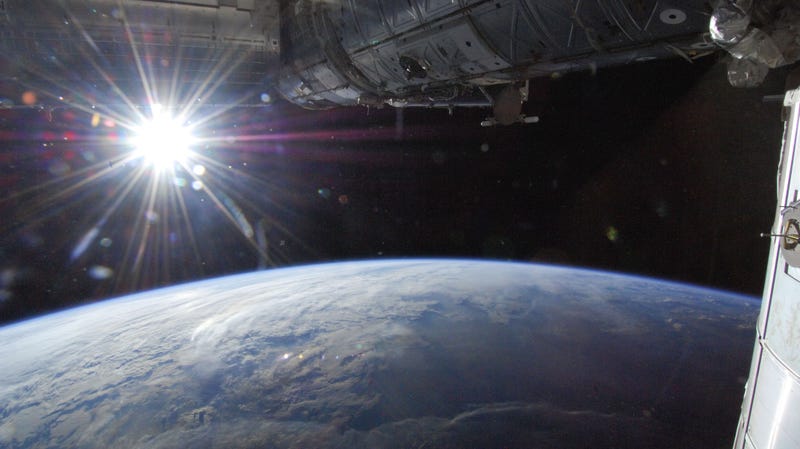 The Sun and Earth, seen from the International Space Station.Photo: NASA
The Sun and Earth, seen from the International Space Station.Photo: NASA
All-time heat records have been set around the world this week, in North American cities including Denver, Colorado; Burlington, Vermont; and Montreal, Quebec; as well as in cities in Europe and Russia. But here’s something that might confuse you: Today is also aphelion day—the day in Earth’s orbit that it is farthest from the Sun. What gives?
I know that you, a Gizmodo reader, are well aware of how the seasons work. But maybe someone you know thinks that the hottest part of the year is when the Earth is closest to the Sun. So let’s break it down.
The Earth travels in an ellipse around the Sun. At its farthest point, which will occur today, July 6 at at 12:46 pm EDT (9:46 am PDT), the Earth will be 94,507,803 miles (152,095,566 kilometers) away from the sun. On average, it’s around 93 million miles (150 million km) from the Sun, and on January 3, 2019, it will be 91,403,554 miles (147,099,761 km) from the Sun.
That’s not a huge difference, if you think about the vastness of space. Instead, the seasons are determined by the directness of the Sun’s rays, which is determined by Earth’s tilt.
The Earth is tilted at a 23.5 degree angle in its orbit around the Sun. That means during June and the surrounding months, Earth’s northern half points at the Sun, and during the January and its surrounding months, Earth’s southern half points at the Sun. During March and September, the sunlight hits both hemispheres equally.
The more direct the sun’s rays, the more light reaches Earth per unit area. Think about holding a bunch of straws, where each straw is a ray of sunlight, and trying to fit them into the glass, the Earth’s surface. If your glass’ rim lines up with the straws, more of them will fit than if you hold the glass at an angle to the straws. More straws, more rays; more rays, more energy; more energy, more heat.
As to why the northern hemisphere is so particularly hot right now, well, it’s complicated. It is the summertime, so you should expect it to be hot, and you should also expect there to be random fluctuations such that sometimes it’s hotter than normal—and no, you can’t blame a single statistical fluke in the Earth’s heat on climate change. Greg Porter at the Washington Post explains that there’s a heat dome over much of the Earth’s north half—a region of high pressure a few miles up in the atmosphere is compressing the air, adding to the summer heat.
But you can’t leave climate change out of it. As things trend warmer, we can expect to see oppressive heat waves like these more often. And we do—2015 was the second-warmest year on record, 2016 was the warmest year on record, and 2017 was the third-warmest year on record, according to NOAA.
So, I know you’re probably thinking, “uh, I knew this already.” But I promise you that you have coworkers, friends, and relatives who think that it’s hottest when the Earth is closest to the Sun. Sharing this knowledge will make you very popular at parties.